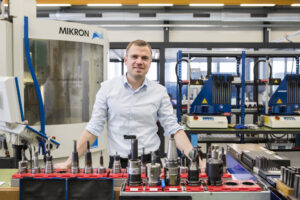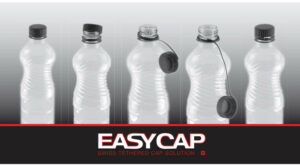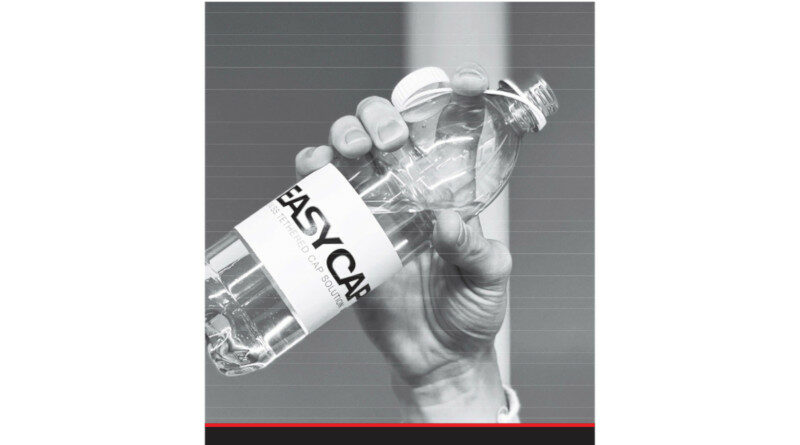The easy solution
Swiss made tethered closure

From 2024 onwards, all plastic caps have to remain connected to the single-use container, in accordance with the EU Single-Use Plastics Directive, 2019/904, Article 6. As a result, there are now numerous designs of tethered caps with different manufacturing processes on the market. PETplanet spoke to Manuel Büsser, CEO of EasyCap, about his multiple award-winning tethered cap solutions.
PETplanet: EasyCap has won both the World Packaging Award and the German Packaging Award. What are the advantages for the consumer when using packaging with EasyCap?
Büsser: From the very beginning, our primary goal was to develop a tethering system that not only complies with EU directives, but also puts the needs of consumers first. Our EasyCap solution gives the consumer the greatest possible freedom to open and close the cap with the usual sequence of movements. Another advantage is the freedom to drink that they have been accustomed to up to now. With our tethering solution, the cap is not in the face region during consumption. When the consumer opens a bottle with our EasyCap tethering, he naturally unscrews the cap from the mouth and lifts it off. No unaccustomed flipping over a hinge is necessary. Replacing the cap is also very easy, allowing the consumer to screw the cap back onto the muzzle as usual. With our EasyCap tethering, we assist consumers in easily setting the tethering band length that is most comfortable for them. Through haptic feedback, so-called “stop bridges” show the consumer the predefined band lengths. With all these intuitive functions and the continued natural drinking behaviour, we have been able to convince two independent expert jury groups and many consumers of our tethering solution.
PETplanet: Why did you decide on this closure lasso design? What were the challenges in the development?
Büsser: Before we started the development of our EasyCap tethering, we first researched the needs of consumers. The most important development goal for us was to develop a tethering that does not interfere with the consumer and does not require the consumer to relearn the already familiar movement sequences. To this end, we analysed the movement sequences learned from childhood for opening and closing a drinking bottle. The analysis showed that the most natural form of the opening process consists of unscrewing and lifting, and that the closing process consists of putting on and screwing down. To realise the two such simple movements in a tethering without adding another movement was a big challenge. The first prototypes were not very well accepted by consumers. The reason for this criticism was that the tethering band was much too short, which consumers found annoying because the cap scratched their face while drinking. After several iterations, we came up with our award-winning tethering solution, where the consumer decides what distance the cap should be from the mouth and thus from the face. Furthermore, our solution also prevents the consumer from tearing off the cap unintentionally. This is because we have observed that consumers who want to drink from bottles with a flip-top tethering cap tear off the cap immediately after opening it so that they can then drink effortlessly from the bottle.
PETplanet: What advantages do closure producers have when they opt for EasyCap?

Büsser: Our aim was to develop a tethering system that requires no or only minor adjustments to the existing cap design for most cap types. Therefore, it is possible to implement our EasyCap tethering with only minor investments in existing or new injection moulds. We have succeeded in doing this because we do not generate our tethering design with a slide mould, but introduce it subsequently by means of slitting. This also has the advantage that our customers can respond to consumer needs within a very short time and without costly modifications to the injection moulds. Another advantage is the minimal space requirement of the slitting technology, which, in contrast to slid warranty tapes, creates an almost imperceptible cut line. This feature greatly improves the dimensional stability and resistance of the closure during transport and during application on the filling line. Thus the closure can also be processed mostly without any adjustments on existing or new filling lines.
PETplanet: What were the difficulties and technological challenges with the slitting?
Büsser: Although slitting is, from our point of view, the best technology for tethering, we had to acknowledge, along with our partners, that every technology has its limitations. Fortunately, we found innovative solutions to work around these limitations. Probably the biggest task was to eliminate the strength degradation at the beginning and end of the cut. This could only be solved by a special cut design, which massively increased the notch strength at these points. The special cut design also makes it possible to optimise the strength of slitted hinged ether rings at the respective cut ends and thus save weight. This is because slit hinged ether ring closures are much more affected by this reduction in strength due to the torsional forces when the closure cap is folded down.
PETplanet: In what sizes can EasyCap be produced? What is the material consumption? What features does the closure for your tethering have to have?
Büsser: In principle, EasyCap tethering can be implemented on almost all closures with a folded retaining bead, provided certain design features are taken into account. The slit design has been optimised to cut as close as possible to the unfolded retaining bead without negatively affecting the subsequent folding of the retaining bead.
PETplanet: In what market segment do you see particularly demand?
Büsser: As already mentioned, it was particularly important to us that the consumer can drink directly from the bottle as usual, without having an annoying cap in the immediate vicinity of the face. Therefore, we see a very great potential for our EasyCap tethering in the “on the go consumption” of beverages. This is probably one of the most significant advantages of our tethering!
PETplanet: Where are your forms already being used?
Büsser: We already have some interested parties with whom we are in talks. Some customers have already tested the first prototypes and are convinced by our solution. In a nationwide survey, the majority of consumers were positive about our solution.
PETplanet: What do you want for the future?
Büsser: We would like EasyCap to be made available to consumers, through one or more global partners in Europe and around the world.
PETplanet: Thank you very much.

